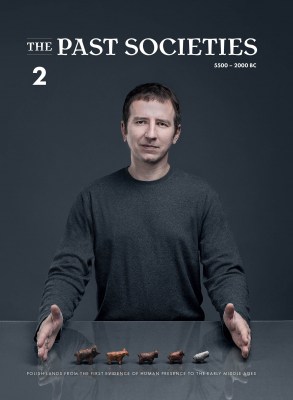 The Past Siocieties T 2, 5500-2000BC
The Past Siocieties T 2, 5500-2000BC
The Past Societies 2
Informacje bibliograficzne
Istnieje również możliwość zakupu wersji cyfrowej w iBooks Store
Tytuł: The Past Societies 2. Polish lands from the first evidence of human presence to the Early Middle Ages: 5500-2000 BC
Redaktor tomu: Piotr Włodarczak
Wydawca: Instytut Archeologii i Etnologii PAN
Miejsce: Warszawa
Rok wydania: 2017
Język: angielski
Liczba stron: 397
Format: A4
Okładka: twarda
ISBN: 978-83-63760-96-0
Opis
As far as Polish archaeology is concerned, the time has clearly come for preparing such a synthesis, since the previous work of this kind (Prahistoria ziem polskich l-V) was published over 25 years ago. The new discoveries, new interpretations, and new research approaches developed by the new generation of scholars studying the material remains of the past urgently require a proper synopsis. [...]
The present volumes are the work of 60 authors formally divided into five teams. In order to curb the "separatist" effects of the traditional systematization of prehistory and protohistory (into the Palaeolithic Era, the Mesolithic Era, the Neolithic Era, the Bronze Age, the Iron Age, and the Early Middle Ages), we employed a strictly chronological criterion: volume one encompasses the period between ca. 500,000 BC and 5,500 BC; volume two - between 5,500 BC and 2,000 BC; volume three - between 2,000 BC and 500 BC; volume four - between 500 BC and 500 AD; and volume five - between 500 AD and 1000 AD. Such an artificial division mitigates the sharpness of the traditional "pivotal moments" and at the same time emphasizes the accelerating nature of socio-cultural changes. [...]
Spis treści
Preface
Piotr Włodarczak
1. The Neolithic and its consequences
2. Environmental and climatic changes
3. Transitional - central - border area
4. Chronology and cultural diversity
5. Investigations in the past
Bibliography
Chapter 1 - The first farmers from the south - Linear Pottery culture
Agnieszka Czekaj-Zastawny
Introduction
1. The cultural situation in Europe in the 6th millennium BC
2. The origins of Linear Pottery culture, the exit areas, and migration
3. Development of the settlement of the earliest farmers in the Vistula and the Odra river basins. Origins and periodization
4. Regional distribution and settlement diversification
5. The organization and development of settlements
6. Human burials
7. Elements of a production economy
8. Exchange contacts
9. The disappearance of the LBK settlement
Bibliography
Chapter 2 - The Danubian world and the dawn of the metal ages
Sławomir Kadrow
Introduction
1. The concept of the Copper Age/Eneolithic
2. Younger Danubian cultures in Polish lands. The history and the state of research
3. Chronology and basis for cultural taxonomy
4. Settlement patterns
5. Settlement micro-regions
6. Settlements
7. Dwellings
8. The economy. The basis of subsistence
9. Flint production
10. Metallurgy and copper products
11. Salt production in south-eastern Poland and other fields of production activities in north-western Poland -Kujawy
12. Funeral rites
13. Visual arts and figurative depictions
14. Society
15. Models of cultural change
16. Final remarks
Bibliography
Chapter 3 - Hunter-gatherers and the first farmers
Agnieszka Czekaj-Zastawny, Jacek Kabaciński
Introduction
1. Early agrarian colonization of Polish lands and the first contacts with the Mesolithic world
2. The 5th millennium BC - an intensification of contacts
3. Integration of the systems - the Brześć Kujawski group of the Lengyel culture
4. Towards the transformation of the system - the Northern group of Funnel Beaker culture
5. Conclusions
Bibliography
Chapter 4 - Ubiquitous settlers, consequent farmers, and monument builders
Marek Nowak
Introduction
1. Dating the onset of the TRB and its origins in Polish territory
2. Typological (pottery), chronological, and territorial trajectories
3. Settlement
4. Subsistence economy
5. The funeral rite
6. Pottery
7. Chipped lithics
8. Remaining indications of the economy
9. Contacts with other systems of information flow
10. Conclusions: the birth, heydays, and fall of TRB societies in Polish lands
Bibliography
Chapter 5 - From south to north. Baden culture people and their neighbours
Agnieszka Przybył
Introduction
1. The Eneolithic - the era's cultural background
2. The Baden complex - general characteristics
3. The northern periphery of the Baden complex ecumene
4. Baden complex inspirations and innovations in the interfluve of the Odra and Vistula rivers
5. From south to north. The population of the Baden culture and its neighbours
Bibliography
Chapter 6 - Collective graves, flint axes, and cows. The people of Globular Amphora culture on the Vistula and Odra
Marzena Szmyt
Introduction
1. General characteristics
2. The history of research
3. Chronology and periodization
4. Material basis: the remains of settlements and camps, funeral sites, artefacts, and ecofacts
5. The natural and cultural environment
6. Residential units: houses and huts
7. Campsites and settlements
8. Larger spatial structures
9. Subsistence strategies
10. Production: raw materials and technologies
11. Distribution and consumption of goods: access and exclusion
12. The living towards the deceased. The funeral rite as a form of manifesting group identity
13. Economy and ritual: the social and symbolic importance of domestic animals
14. Technical innovations
15. Basic social groups
16. Intra-group relationships
17. Between stability and mobility
18. External relations: cohabitation, cooperation, competition
19. Globular Amphora culture: a form of material culture or something more?
20. Mechanisms of persistence 262 21. The origin and legacy
Bibliography
Chapter 7 - Battle-axes and beakers. The Final Eneolithic societies
Piotr Włodarczak
Introduction
1. Corded Ware
2. Bell Beakers
3. The history of research
4. The environment and regions
5. Stages of cultural development and absolute dating
6. Models of settlements
7. Kurgan ideology
8. Burials
9. Old vs. new. The phenomenon of the "syncretization" of funeral behaviour
10. The phenomenon of Złota
11. Catacomb graves
12. The importance of the funeral rite
13. The A-horizon and the problem of its origin
14. Emigrants from the south
15. Economy and subsistence strategies
16. Raw materials and technologies of the Final Eneolithic
17. Interregional links
18. War and warriors
19. Mobility
20. The organization of groups
21. The Final Eneolithic Beaker societies: a syndrome of the time, or maybe something more?
Bibliography
Chapter 8 - Beyond the world of farmers: the Subneolithic, 4000-2000 BC
Jarosław Sobieraj
Introduction: The Neolithic "as usual"...
1. ...and "another" Neolithic
2. Identification of the phenomenon
3. Problems of taxonomy
4. Prologue to the phenomenon
5. On the borders of worlds
6. The first interactions
7. The further impact of the agricultural milieux
8. Natural and social obstacles
9. The returning wave?
10. The third stage of neolithization
11. The "last shelter" of the Subneolithic
12. The end of the transformation
14. Environmental issues and the economic models
Bibliography
Chapter 9 - Dagger means power: Western Poland, 2300-2000 BC
Urszula Bugaj
Introduction
1. In the archaeological record
2. Final Neolithic tradition in a nutshell
3. Early Bronze Age trends
4. Development of metallurgy
5. Final remarks
Bibliography
Chapter 10 - Towards the Bronze Age in south-eastern Poland (2300-2000 BC)
Piotr Włodarczak
Introduction
1. Regions
2. Dating
3. The settlement model
4. Settlements
6. Economic issues
7. Cemeteries and graves
8. Technological innovations?
9. Chrono-cultural matters
10. Early Bronze Age societies in Małopolska
Bibliography


